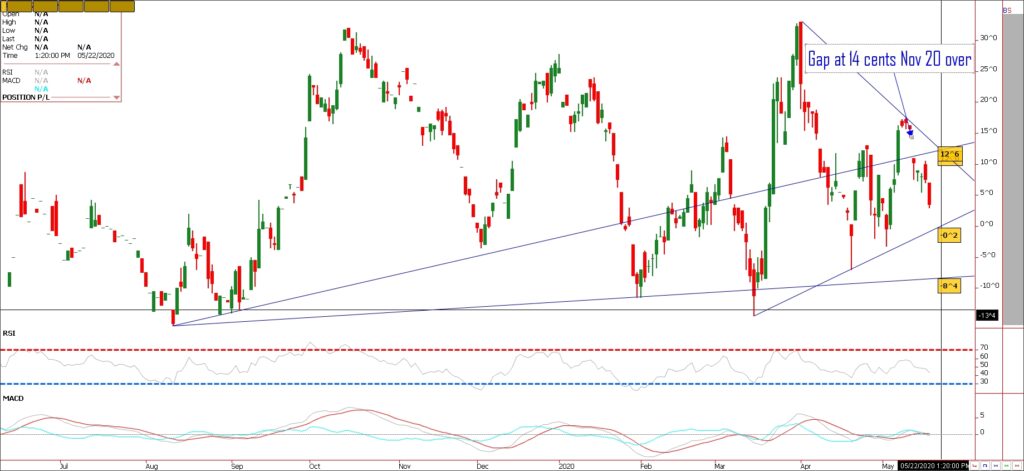Commentary: The USDA today announced another round of farmer aid
payments based on either half of 2019 production, or total on
farm stocks as of January 15th, at 45 cents per bushel for soybeans,
32 cents for corn, and 18 cents for hard red spring wheat. Funding
was also announced for payments to specialty crop and livestock
producers. These payments come in the form of Covid 19 assistance as ethanol and feed demand have been significantly reduced due to the virus. Export demand has also been severely reduced again as Countries around the Globe due to reduced commerce, have opted to reign in their own supplies and deplete their reserves. I have been talking about this possibly being bullish in the long term as monetary easing and money printing has expanded at a record pace. Combined with thoughts that should these reserves eventually need to be replenished, it could create a bid in the grain market in the late third quarter/ end of year time frame. If you throw in weather issues that curtail production, an uptick in volatility amid sizable rallies could be seen. To be clear we are not in that enviroment. The US is the second or third rung on the global export ladder for corn, wheat, and soybean sales. Its simply cheaper for major buyers to buy from South America or the Black Sea as those currencies are significantly cheaper than the Dollar. Brazil is currently selling a lot of beans to China, one reason is because the Brazilian Real is low and the American Dollar is strong. Brazilian farmers are paid in American dollars for the beans and their expenses are paid in Reals. For obvious reasons I think the US farmer would rather have market share returned instead of filling out forms for aid payments.
Last week the USDA in some shape or form gave us bearish data on soybeans, corn, and wheat. If it wasn’t domestic ending stocks that came in bearish, the USDA gave the market bearish global ending stocks data for both old and new crop ending stocks. In my view they have made some aggressive assumptions globally on future production. The numbers will be adjusted in future reports most likely as Mother Nature will have the final say on crop tallies. One area that was noticeable for me was the 20/21 soybean ending stocks number at 405 million bushels. While ample and a good cushion, its lower than two crop seasons ago at 438 million. Prices prior to the Trade war in 2018 sat between 9.30 and 10.80. I see this ending stocks number as low and a potential buying opportunity should weather emerge. On the flip side I think the number also represents assumed China buying to meet the terms of the Phase One Deal. Until we see either demand or weather problems, rallies will be sold as the deflationary enviroment the grains are in currently could persist. This time of year though a short term rally is favored in my view as uncertainties abound over the planting and growing season. Two trades to consider. One is a futures spread; Nov20/21 soybeans and the other is an option trade for something way down the calendar. Below is the November 20/21 bean chart.

Trade Recommendation
Futures: Buy the Nov 20 soybean and sell the Nov 21 soybean spread at parity or zero. (upward trendline)
Options-Sell the July 2021 11.00/10.00 put spread for 93 cents.
Risk/Reward
Futures- If filled, place a GTC sell stop at 8 cents Nov 20 under for a risk of 8 cents or $400.00 plus commissions and fees. Im looking for an eventual rally towards the gap for a 14 cent gain or towards the high of the year at 32 cents Nov 20 over.
Options-Long term bet with defined risk. This strategy collects 93 cents ($4650.00) minus commissions and fees upon entry. The goal is to sell high and buy back low with a static bullish position. We are looking for a rally down the road and to buy back this spread for 45 cents. Risk is seven cents or $350.00 plus trade costs and fees.
Please join me for a free grain and livestock webinar at 3pm Central. Signup is free and a recording link will sent upon signup. We discuss supply, demand, weather and the charts along with trade idead both hedge and speculative. Sign Up Now
Walsh Trading, Inc. is registered as a Guaranteed Introducing Broker with the Commodity Futures Trading Commission and an NFA Member.
Futures and options trading involves substantial risk and is not suitable for all investors. Therefore, individuals should carefully consider their financial condition in deciding whether to trade. Option traders should be aware that the exercise of a long option will result in a futures position. The valuation of futures and options may fluctuate, and as a result, clients may lose more than their original investment. The information contained on this site is the opinion of the writer or was obtained from sources cited within the commentary. The impact on market prices due to seasonal or market cycles and current news events may already be reflected in market prices. PAST PERFORMANCE IS NOT NECESSARILY INDICATIVE OF FUTURE RESULTS.
All information, communications, publications, and reports, including this specific material, used and distributed by Walsh Trading, Inc. (“WTI”) shall be construed as a solicitation for entering into a derivatives transaction. WTI does not distribute research reports, employ research analysts, or maintain a research department as defined in CFTC Regulation 1.71.
